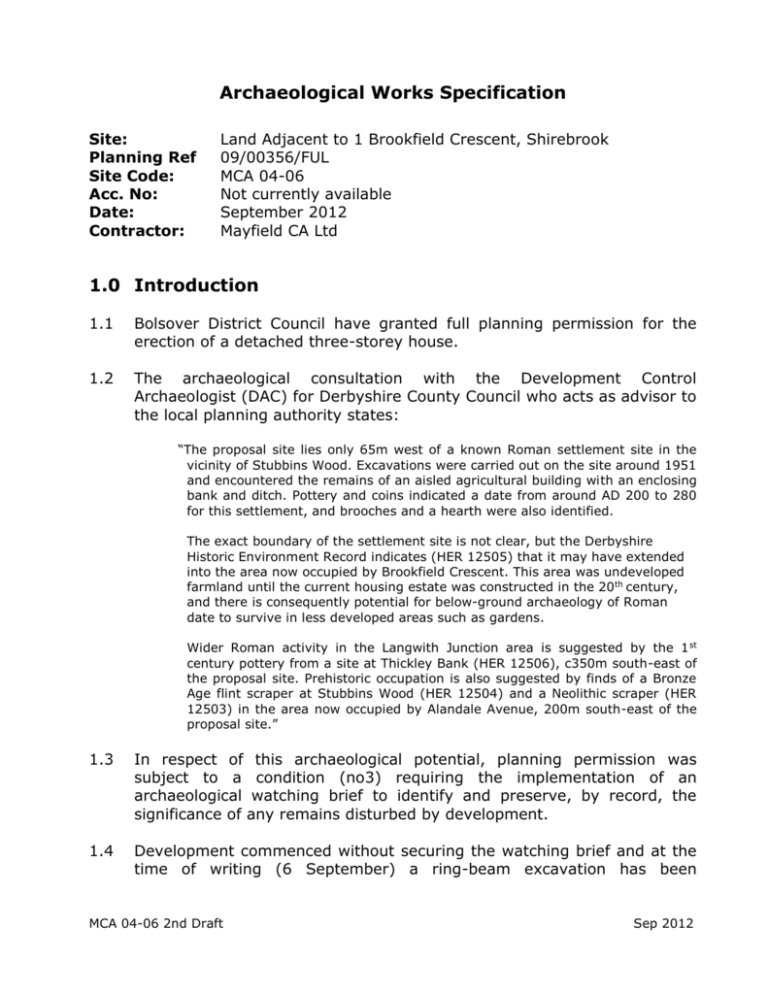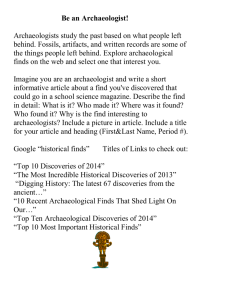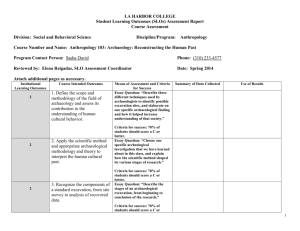Waitrose Foodstore, Wallingford, Oxfordshire
advertisement

Archaeological Works Specification Site: Planning Ref Site Code: Acc. No: Date: Contractor: Land Adjacent to 1 Brookfield Crescent, Shirebrook 09/00356/FUL MCA 04-06 Not currently available September 2012 Mayfield CA Ltd 1.0 Introduction 1.1 Bolsover District Council have granted full planning permission for the erection of a detached three-storey house. 1.2 The archaeological consultation with the Development Control Archaeologist (DAC) for Derbyshire County Council who acts as advisor to the local planning authority states: “The proposal site lies only 65m west of a known Roman settlement site in the vicinity of Stubbins Wood. Excavations were carried out on the site around 1951 and encountered the remains of an aisled agricultural building with an enclosing bank and ditch. Pottery and coins indicated a date from around AD 200 to 280 for this settlement, and brooches and a hearth were also identified. The exact boundary of the settlement site is not clear, but the Derbyshire Historic Environment Record indicates (HER 12505) that it may have extended into the area now occupied by Brookfield Crescent. This area was undeveloped farmland until the current housing estate was constructed in the 20 th century, and there is consequently potential for below-ground archaeology of Roman date to survive in less developed areas such as gardens. Wider Roman activity in the Langwith Junction area is suggested by the 1 st century pottery from a site at Thickley Bank (HER 12506), c350m south-east of the proposal site. Prehistoric occupation is also suggested by finds of a Bronze Age flint scraper at Stubbins Wood (HER 12504) and a Neolithic scraper (HER 12503) in the area now occupied by Alandale Avenue, 200m south-east of the proposal site.” 1.3 In respect of this archaeological potential, planning permission was subject to a condition (no3) requiring the implementation of an archaeological watching brief to identify and preserve, by record, the significance of any remains disturbed by development. 1.4 Development commenced without securing the watching brief and at the time of writing (6 September) a ring-beam excavation has been MCA 04-06 2nd Draft Sep 2012 completed and works are on-hold awaiting approval and implementation of the details of a watching brief. 1.5 This document is the written scheme of investigation for mitigating the remaining developmental threat. It has been produced in accordance with the standards and guidance of the Institute For Archaeologists and common practice. 2.0 Scope of works 2.1 All remaining ground works will be subject to archaeological control. This includes the service trenching and formation strip for the access drive. These works will only be undertaken under archaeological supervision. 2.2 Any excavation works undertaken without archaeological monitoring and which have not been approved in advance by the project archaeologist and/or the DAC will be contrary to this approved written scheme of investigation and therefore a breach of planning permission. 2.4 Any such breaches of the protocols detailed in this document will be reported to the DAC and the local planning authority may take enforcement action. 2.5 On-site monitoring will include recording of field observations on the natural stratigraphy and any modern truncation events exposed; with detailed recording and hand excavation of any in situ archaeological remains. 2.6 On completion of site works, the DCA will be informed of the completion of fieldwork. An ordered archive will be prepared and a report on the findings submitted to the local planning authority and Derbyshire County Council for approval. 2.7 Once approved, an OASIS form will be completed and a copy of the report uploaded. A copy of this form will also be submitted to the Derbyshire Historic Environment Record with a copy of the approved report. 2.8 Mayfield CA Ltd will temporarily retain the project archive until arrangements are made with the Derbyshire Record Office for the longterm curation of the archive paper element. The object element of the archive will either be returned to the landowner, retained by Mayfield CA Ltd or discarded in accordance with regionally agreed criteria as deemed MCA 04-06 2nd Draft Sep 2012 appropriate in consultation with the DAC. A summary report will be published in the Derbyshire Archaeological Journal. 2.8 The watching brief will be implemented in accordance with the following method statement. 3.0 Method Statement 3.1 Mobilisation and staffing 3.1.1 Prior to the commencement of site works, a risk assessment will be undertaken. If this results in any requirement to revise the watching brief methodology works will be suspended until the implications are discussed with the development control archaeologist and any revisions agreed. 3.1.2 The duration of the fieldwork and staff levels will be determined by the quantity and nature of any remains exposed. Provisionally, the observation of reduced excavation, mapping and recording element will be undertaken by one archaeologist, but additional staff may be required for investigation depending on the complexity and quantity of any features. 3.2 Machine excavation 3.2.1 Deposits removed by machine will be excavated in spits of approximately 100mm and the resultant surface and spoil of each spit examined for artefacts including random sieving of c. 30 Litre samples for artefact recovery. Site preparation and soil stripping must be undertaken with a toothless ditching bucket. Excavation of foundation and service trenches should be by toothless or bladed bucket, although a toothed bucket or concrete breaker may be used where necessary to remove obstructions. 3.2.2 Where significant archaeological deposits are identified, machine excavation will cease and further investigation will be undertaken by hand. Should significant assemblages of small remains such as flints or metalwork be identified, the sample of soil sieved will be intensified and scanned with a metal detector. Finds recovered from any such enhanced sampling will be recorded with reference to a site grid to enable spatial interpretation. MCA 04-06 2nd Draft Sep 2012 3.3 Hand excavation 3.3.1 Following hand-cleaning, as required, any identified features will be investigated in order to establish the nature and chronology of the deposit sequence. 3.4 Site Recording 3.4.1 As a minimum, the site stratigraphic sequence will be recorded within each ground work unit (i.e. reduced level excavation, service trench etc.). 3.4.2 Each distinct deposit will be given a unique context number and recorded on a pro-former context sheet. 3.4.3 Sample sections of the stratigraphic sequence and plans and sections of all archaeological features will be drawn at scale, nominally 1:20, but other scales may be used as considered appropriate. 3.4.4 Structural remains will similarly be recorded and their constituent parts further recorded, if necessary, on pro-forma brick and timber recording sheets. 3.4.5 A 35mm photographic archive will also be produced in monochrome supplemented by colour digital images of 12m pixels taken with a professional grade DSLR in uncompressed TIFF format. Each frame will include, where appropriate, a photographic scale and board with site code, context number and direction of north. 3.4.6 Additional pro-forma record sheets will list drawings, photographic descriptions, samples and finds. 3.5 Finds collection & Environmental Sampling 3.5.1 All artefacts excluding obviously modern material will be collected. Finds will be bagged and labelled with the site code and context number of the deposit from which they were recovered. Where remains are discarded on site, a summary record of artefact type, quantity and reason for discard will be recorded. 3.5.2 Any deposits considered suitable for environmental investigation will be sampled in accordance with the Environmental Archaeology (English Heritage 2011) guidelines. Where complex deposits of possible MCA 04-06 2nd Draft Sep 2012 environmental significance are identified, a site-specific sampling strategy will be prepared by an independent environmental consultant and agreed with the DAC. 3.5.3 Waterlogged remains are not anticipated on this Site, but if deposits are encountered that have the potential for a waterlogged environment then a specific method statement will be prepared by an independent environmental consultant and agreed with the DCA. 3.5.4 Account will also be taken of any deposits that have the potential for, and merit, scientific dating. 3.5.5 If human remains are identified they will be initially left in situ and reported to the Coroner, police and DCA. Should their removal be considered necessary, this will be undertaken following receipt of a licence from the Ministry of Justice. On completion of any analysis by a suitably qualified osteologist, the remains will disposed of in accordance with the terms of the licence. 3.5.6 Should any finds be discovered which might be construed as Treasure under the auspices of the Treasure Act (1997), they will be reported to the Coroner. 3.6 Monitoring and Completion of Fieldwork 3.6.1 The DCA will be given a minimum of one week written notice of the commencement of fieldwork including the contact details of the site operative who will provide the DCA with progress reports on an ad hoc basis. 3.6.2 The DCA may exercise the right to monitor the implementation of this written scheme of investigation on the behalf of the local planning authority. The purpose of any such visit is to ensure that the fieldwork element has been undertaken in compliance with this document and to determine if any additional works are required. 3.6.3 When site works are complete, the DCA will be informed and the site archive prepared. 3.7 Site Archive preparation 3.7.1 On completion of fieldwork, the DCA will be informed in writing. All records will be checked for errors and omissions and corrected as MCA 04-06 2nd Draft Sep 2012 necessary. Retained finds will be processed and treated in accordance with A strategy for the Care and Investigation of Finds (English Heritage 1995) prior to their specialist assessment. 3.7.2 The range of specialist provision will be dependant on the date and type of finds discovered, but it is anticipated that the following specialists may be required: 3.8 Medieval and post-medieval pottery Chris Cumberpatch/Jane Young Environmental sampling Archaeological Services WYAS Industrial Residues Rod Macenzie Animal Bone Archaeological Services WYAS Human Remains to be agreed with the DCA if required Report 3.8.1 A report on the results of the works will be produced once all specialist reports are available. This document will include relevant background material; a description of the methodology and a description and analysis of the site deposits and finds. 3.8.2 The report will be illustrated by site drawings and a selection of frames from the photographic record. 3.8.3 The layout and extent of the report will depend on what, if anything, is found but is likely to include: Introductory statement Aims and purpose of the project Methodology An objective summary statement of results Conclusion Supporting illustrations at appropriate scales, all to include levels tied to Ordnance Datum. Drawings should follow the conventions developed in the MoLAS Archaeological Site Manual (1994) Illustrative site photography, including key features and working shots Supporting data – tabulated or in appendices, including as a minimum a basic quantification of all artefacts, ecofacts and structural data. Index to archive and details of archive location; confirmation of archive transfer arrangements including a provisional timetable for deposition. References MCA 04-06 2nd Draft Sep 2012 3.8.4 Copies of the report will be issued to the client for approval and then to the DCA for approval. Once approved by the DCA, the OASIS form will be completed and a copy of the report uploaded. A copy of the form will be submitted to the Derbyshire Historic Environment Record along with a hard copy and digital copy of the report in .pdf format, accompanied by site images. 3.8.5 Once the final report has been accepted, the project archive will be finalised in accordance with Procedures for the Transfer of Archaeological Archives (Derbyshire Museums 2003). Where the projected results in an object element this will be retained as part of the archive by Mayfield CA Ltd or discarded in accordance with agreed protocols where deemed acceptable unless the landowner exercises their right to retain it. Archives with a retained object element will be temporarily retained by Mayfield CA Ltd until arrangements are made for deposition with an appropriate repository for long-term curation. Where the project results in a paper element only (or the object element is discarded/retained by the client) the paper element will be deposited with the Derbyshire Record Office. The DAC will be informed in writing of the fate of the archive and addition written confirmation given when the archives are deposited. 3.9 Publication 3.9.1 The scope of publication will be dependant on the results of the watching brief. As a minimum, however, a summary of the project supported with illustrations and plates as appropriate will be submitted to the editor of County journal Derbyshire Archaeological Journal for publication in a future edition within two years from completion of the project. 3.9.2 Should the results merit wider publication, then an article will be prepared for one of the national period journals. 4.0 Timescale summary OASIS initiation Prior to commencement of site work Fieldwork TBC by client Archive Prepared on completion of fieldwork MCA 04-06 2nd Draft Sep 2012 Report interim within six weeks and full report within six months of the completion of fieldwork OASIS completion On acceptance of final report Publication within two years of the completion of fieldwork Contacts Simon Johnson Mayfield CA Ltd Steve Baker Development Control Archaeologist 01629 – 539 773 MCA 04-06 2nd Draft 01246 – 232 335 07922 – 059 069 Sep 2012





